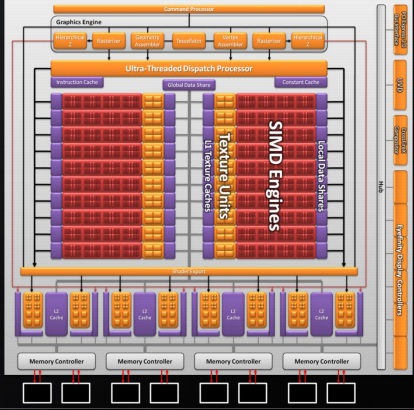Straight down the middle
We know that AMD has to use the Radeon HD 5870 architecture and trim it down in such a way as to maintain decent performance at a significantly lower price point. We reveal how it's done by looking back at the silicon progenitor.The state of play

Evaluated in simple terms, the big-dog Cypress GPU packs in 1,600 stream processors grouped in 20 SIMD arrays containing 80 SPs each. Each SIMD array has four texturing units that ultimately connect to 32 raster back-ends and, in turn, to four 64-bit memory-controllers.
The math upshot is that Radeon HD 5870 can theoretically push 2.72TFLOPS of single-precision compute power that's backed up by card-wide GDDR5 bandwidth amounting to 153.6GB/s.
Huge processing numbers are manifested in a 2.15bn transistor chip that takes up around 334mm² on TSMC's 40nm fabrication process.
Radeon HD 5850 reduces the SIMD arrays to 18, lowers card clocks, but keeps the back-end, and much else, the same.
Straight down the middle for Radeon HD 5770

SIMD arrays drop from 20 to 10, texture-units from 80 to 40, ROPs from 32 to 16, and GDDR5's bus-width from a combined 256 bits to 128 bits.
Indeed, following the divide-by-two rule to the letter, Radeon HD 5770's clocks at a HD 5870's levels. That means an 850MHz core speed allied to 1GB of GDDR5 operating at 4,800MHz.
The halving of the architecture is also reflected in an under-load power-draw of 108W - just over half the HD 5870's 188W - and idle-draw of just 18W.
Pragmatically, AMD has suggested an etail price of around $159 for the card, pitching it in line with the GeForce GTX 260 896MB and Radeon HD 4870 1,024MB.
An almost-perfect split for HD 5750, too
The cheaper Radeon HD 5750 1,024MB closely adheres to the split-in-two philosophy, as well. It's exactly half a Radeon HD 5850 in terms of basic design. Clock-speeds differ a touch, however, from 700MHz (HD 5750) vs. 725MHz (HD 5850) core speed and 4,600MHz GDDR5 vs. 4,000MHz.
Power-draw is expectedly better than HD 5770. AMD quotes a maximum draw of 86W, and 16W when idling.
Continuing theme of half, transistor-count is also chopped from 2.15bn to 1.04bn, and that, according to AMD, translates to a die-size of 185mm² on the 40nm process.









